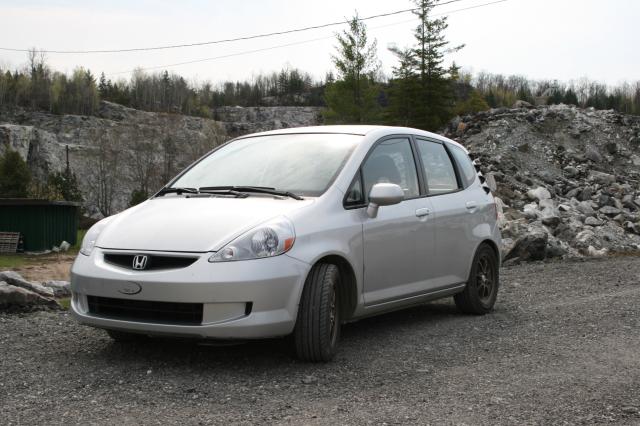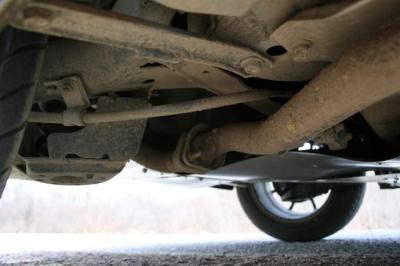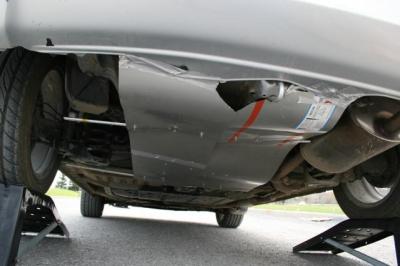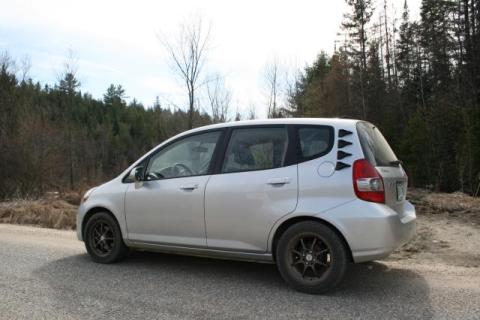A Modest Aerodynamic Update for the Honda Fit


2007 was a bad year for aerodynamics at Honda.
Their F1 racing team got it wrong, and I believe Honda could've done better with the Fit as well.
If they had paid a bit more attention to aero, it could perhaps be closer to matching the CRX for fuel efficiency.
The underbody is relatively smooth until the air gets to the gas tank, after which it does not look so good.
The rear bumper cover hangs down too low, and the space immediately before it does not to my untrained eye look ideal for aerodynamic performance.
Last year, I added vortex generators which seemed to reduce drag a bit as promised. But I did
not quite get my car to 40 miles per gallon, and in the pursuit of that nice round number, given my stubborn unwillingness
to adjust my driving style, I decided to bolt some sheet metal to the bottom of the car. I had in mind a rear
diffuser, the defining characteristic of which is that it slopes upwards at the back.
Getting the best angle would involve cutting out a large part of the rear bumper cover, and I have not yet been so ambitious.
Instead I simply bolted some aluminum to the bottom of the car to serve as a mostly-flat partial undertray.
This consists of two 1'x3.5' pieces of thin aluminum, which is the most suitable material that happened to be at hand. These are attached to vinyl-coated steel bars from
some sort of modular furniture system. In the rear this is bolted directly to the place where a black triangular thingy used to
be (hope that wasn't structurally important). In the front, it's affixed via two small brackets to conveniently-located bolts. The
front edge of the metal is rather carelessly bent upwards in an attempt to stop it catching the air. The trailing edge is taped to the
bumper. I have no automotive engineering skills and it does not fit very well. It stays on and does not make any noise. Good enough for a prototype, and it's probably just as sturdy as some of the plastic bits Honda put on there: One of the front
mud flaps already fell off during the winter.
AutoSpeed magazine has demonstrated that it is possible to find a significant reduction in drag with a
small front undertray on the 1999 Toyota Prius. They measured 10% less fuel consumption at 100km/h! It seems likely that there is considerable potential for improvement
in underbody aerodynamics on the Fit, but it is difficult to guess how much any given change will help. Therefore, as the Honda F1 team puts their latest aero developments to the test at Barcelona this weekend, I am spending
a bit of time to evaluate my considerably less-sophisticated aero update on the Fit.
Testing at 90km/h
It's been most of a year since my last bit of road-testing aerodynamic devices, the memory of how much fun it is
had faded from my mind, and so I went out to see if I could measure any improvement by looking at fuel
consumption.
Fuel consumed is given in the table below in units nominally of L/1000km as measured by ScanGuageII, but it is not calibrated properly, so the
numbers would need to be corrected by an unknown factor if they were to represent actual fuel consumption. Calibration of the ScanGuage appears to involve simply multiplying its measured
fuel consumption by a constant factor particular to the car, so this should not affect the percentage change observed. Observing it over the past few days, it seems to give fairly consistent measurements.

Two runs in each direction on 6km of road were made for each of the three sets of trials.
The first and third had the aluminum undertray installed, for the second it was removed.
A constant speed of 90km/h was maintained with no acceleration or braking, except for one
downhill section where the speed went slightly above this due to gravity.
The extreme hypermiling technique of obeying the speed limit was used to reduce the chance
of coming up on slower traffic.
Road was oriented close to North-South, wind was light from the East. Temperature gradually rose from 18 to 20 degrees celsius at the nearest weather station over
the duration of testing. To help keep the driver from getting excessively bored while driving
back and forth for two hours, in-car music was provided by the Arrogant Worms, thanks guys.
Even so the driver did not feel motivated to continue testing after this minimum, but hopefully
sufficient, amount of driving at exactly the speed limit on a road unusually straight and level for this part of
the world. There were a few small hills, and from the results you can infer that the elevation was higher at one end.
The car was fully warmed up before each set of trials. Other than one vehicle which did maintain a respectful distance behind, no traffic in the same direction was encountered, as I waited (less than a minute) for an empty road each time. Opposing traffic varied from about three to ten
vehicles in the other direction.
| A1-undertray | B2-removed | A3-undertray |
|---|---|---|
| 67 | 68 | 68 |
| 74 | 79 | 76 |
| 66 | 68 | 67 |
| 76 | 80 | 77 |
| Average fuel consumed: | ||
| 70.8 | 73.8 | 72.0 |
So, an improvement of somewhere around 3% at 90km/h. At least the numbers are consistent enough to say with confidence
that there is some slight improvement. Not bad for 7 square feet of aluminum sheet.
On the Autoroute at 110km/h

As the AutoSpeed article says, "don't expect to do any of this road-testing quickly." This method takes
way too much time for any sane person to bother with it. So I went out for another test, this time on the expressway. A speed of
110km/h was chosen, as that seems to be about the median speed of traffic on this bit of road.
Traffic was medium-heavy: There were other cars in sight more than half the time. Temperature
was steady at 20 degrees celsius. Crosswind 28km/h from the East, gusting to 39. In the CD player
was Front 242 for the first half, then Stereolab. The distance was about 10km, again with some
elevation change along the way.
| A4-undertray | B5-removed | A6-undertray |
|---|---|---|
| 90 | 92 | 91 |
| 81 | 83 | 79 |
| 93 | 90 | |
| 84 | 80 | |
| Average fuel consumed: | ||
| 85.5 | 88.0 | 85.0 |
Again about 3% less fuel consumed with the undertray. I had hoped for better. From the fact
that the observed change in fuel consumption was very close to equal in the two tests,
we can conclude either that something was wrong with one or more of my tests,
or that aerodynamic drag already accounts (indirectly) for a large majority of the fuel consumption at 90km/h.
Both seem entirely possible.
More Work To Do

Only time will tell if I can claim to get over 40mpg in normal driving, but if I do save something like 3%
at least I should break even financially in less than a year, having spent almost $30 on this
so far. Plus about another $20 worth of gasoline burned in testing. My motivation is not really to save on gasoline but just to experiment. Also it is nice
to imagine that I've slightly reduced lift and have an extra horsepower or two available for
acceleration at speed.
Next I will have to replace all the fasteners with stainless steel, find more suitable
brackets to attach the thing, cut it to fit better, attach it to the rear bumper cover in a more
permanent fashion, and make it extend closer to the left side of the car. I think it's worth doing.
This will likely provide at least one more afternoon of entertainment in the weeks to come.
Recent Fuel Consumption
Will keep track here for a few weeks at least. I never did figure out how to fill the gas tank to a
consistent level, so it will take some time to get anything useful here.
| Date | km | Litres | L/100km | MPG(US) | Notes |
|---|---|---|---|---|---|
| last year | 6.06 | 38.85 | |||
| 2008-04-22 | 210.4 | 11.03 | 5.24 | 44.9 | |
| 2008-04-25 | 166.3 | 10.73 | 6.45 | 36.4 | |
| 2008-04-27 | 358.6 | 21.59 | 6.04 | 39.0 | includes testing |
| Total: | 735.3 | 43.35 | 5.90 | 39.9 |